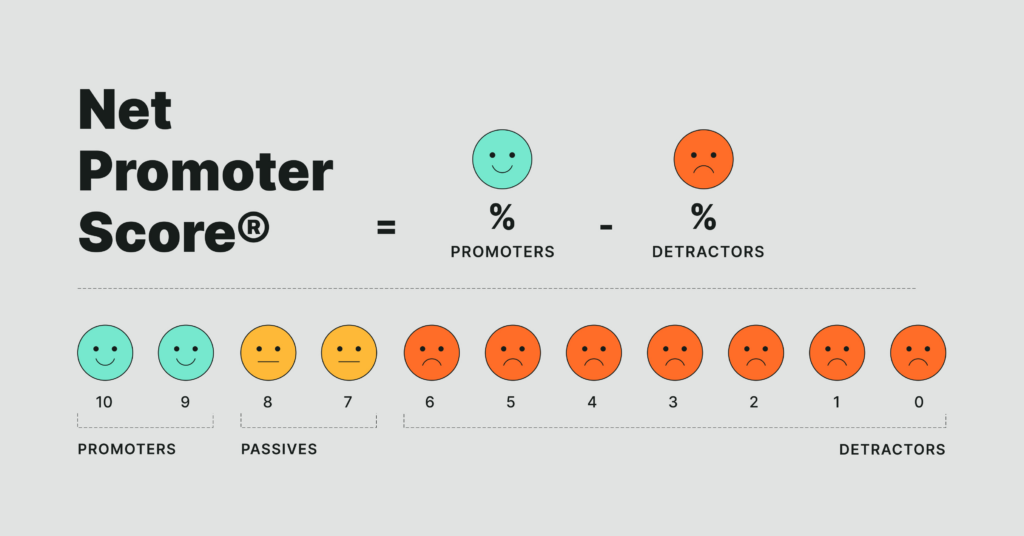ARTICLE
Net Promoter Score (NPS): What it is and How to Calculate it

When it comes to understanding customer loyalty, few tools are as widely used—or as straightforward—as the Net Promoter Score (NPS). You’ve probably seen it in action without even realizing it. Once you’ve spent money with a company or had a service done for you, you’re prompted with one brief question: “How likely are you to recommend us to a friend or colleague?“
That one question has set the world standard for measuring the way consumers feel about brands. But what’s the story behind it, and why is it so important to businesses now?
Let’s take a closer look at what NPS is, how it’s measured, and why it’s an essential component of long-term business success.
What Is Net Promoter Score?
The Net Promoter Score is a measure of customer loyalty created by Fred Reichheld and launched in 2003 by Bain & Company and Satmetrix. Its purpose was to develop a straightforward yet effective method for measuring how customers feel about a brand or experience over time.
Instead of exhaustive surveys with loads of questions, NPS revolves around a single powerful question:
“On a scale from 0 to 10, how likely are you to recommend our company, product, or service to someone you know?”
This single question serves as a measure of customer joy and future actions. It will indicate whether your customers are going to be brand enthusiasts or are quietly losing interest—and perhaps bad-mouthing you.
How Is NPS Calculated?
When you collect feedback, customers are segmented based on their feedback:
Those scoring 9 or 10 are Promoters. They’re really happy, loyal, and enthusiastic about your brand.
Customers scoring 7 or 8 are Passives. They’re relatively satisfied but not very enthusiastic, and they can leave quickly for another company.
Anyone who scores 6 or less is classified as a Detractor. Detractors are unhappy customers who may share unfavorable opinions that spoil your brand perception.
To calculate your Net Promoter Score, subtract the percent of Detractors from the percent of Promoters:
NPS = % Promoters – % Detractors

This gives you a score of between -100 and +100. The higher your NPS, the better the likelihood that your customer base will be satisfied, loyal, and supportive of your brand growth.
Why Does NPS Matter for Your Business?
NPS isn’t a number—it’s a peek into your customer’s mind. When measured on a regular basis, it indicates trends in satisfaction, loyalty, and long-term commitment. Businesses with high NPS tend to have better word-of-mouth recommendations, greater retention, and more stable revenues.
On the other hand, a poor or declining NPS can suggest that there are issues lurking beneath the surface—e.g., poor service, quality problems, or a mismatch between perceptions and actualities.
That’s why so many businesses tie NPS into their overall Churn Solution. By catching at-risk customers early, they can call them, fix problems, and possibly save them from churn. It is so much more expensive to retain a customer than to re-acquire a lost customer.
When and How Should You Use NPS?
One of the advantages of NPS is its versatility. You can use it at different stages in the customer journey:
After a transaction: At this stage, you measure how much a customer enjoyed a specific purchase or service interaction.
Ongoing: As a customer satisfaction program metric to monitor longer-term sentiment.
After onboarding: At this stage, you test how new users feel having just tried your product for the first time.
The most important thing is consistency. Asking the same question over time allows you to track progress, compare results, and catch problems before they become huge issues.
How to Get the Most out of Your NPS Results
The number is just step one. The benefit lies in analyzing feedback and acting on it.
Here’s how to do it successfully:
1. Segment Responses
Notice how different customer segments (e.g., by location, product, or support) respond. That way, you can tailor your improvements.
2. Follow up with Detractors
Speak to unhappy customers and learn more about them. Not only does it make you care, but it can also turn negative experiences into positive ones through word-of-mouth.
3. Celebrate and Learn from Promoters
Promoters are your brand’s biggest fans. Use their feedback to understand what you’re doing right, and replicate it elsewhere.
4. Track Over Time
NPS isn’t a one-time metric. Measure it regularly to track performance and spot shifts in customer sentiment.
Final Thoughts
Net Promoter Score might be a simple question, but it delivers powerful insights. In a competitive market, businesses that listen to their customers—and act on what they hear—are the ones that thrive.
By incorporating NPS into your customer feedback cycle and tying it into a larger retention and churn solution strategy, you’re setting the stage for long-term commitment and growth.
If you’re a startup looking to build trust or a mature brand looking to improve, asking, “How likely are you to recommend us?” can be the most important question you can ask.
















